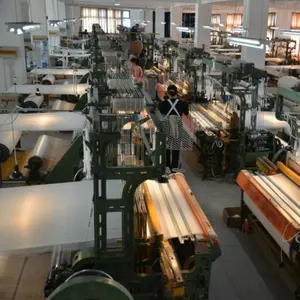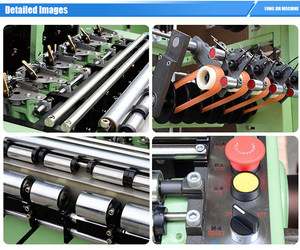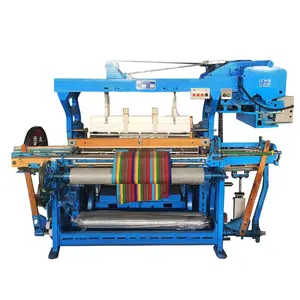(48148 products available)

























































































































































































































Automatic shuttle changing loom refers to the looms with shuttles that can be automatically changed and have different driving modes. The main driving modes are as follows:
The specifications of an automatic shuttle changing loom can differ according to its kind. The table below presents some general specifications for guidance purposes only.
Maintenance of automatic shuttle-changing looms is quite necessary because, with looms, as with all machines, regular maintenance and care prolong life and preserve efficiency. Automatic looms require a special kind of maintenance that is often included in the manufacturing deal. This is provided to ensure no disruption to the factory's production line. Even though looms are large, their essential maintenance procedures are not cumbersome.
Textile factories:
In large-scale textile factories, automatic shuttle changing looms are crucial for mass fabric production. Their high-speed weaving capabilities and automatic shuttle changing functions enhance productivity, enabling the seamless manufacturing of various fabric types.
Garment factories:
Garment factories require diverse fabrics. Automatic shuttle changing looms provide efficient fabric weaving services to meet garment production needs, ensuring consistent quality and timely delivery of fabrics for garment manufacturing.
Upholstery manufacturing:
Upholstery manufacturers need to produce high-quality upholstery fabrics, such as curtains, sofas, and car seat covers. Automatic shuttle changing looms can meet these requirements, providing precise weaving functions and a wide range of design options to create durable and stylish upholstery fabrics.
Home textile production:
Home textile manufacturers require various home textile fabrics, such as curtains, bed linen, and towels. Automatic shuttle changing looms can efficiently meet these demands, producing a wide range of home textile materials.
Industrial textile production:
Industries like filter cloth, conveyor belts, and mining need industrial textile fabrics. Automatic shuttle changing looms can efficiently produce a variety of technical textile materials, meeting the needs of industrial production.
Custom fabric services:
Some specialized textile companies offer customized fabric services. Automatic shuttle changing looms can provide personalized weaving services to meet the unique design and quality requirements of different customers.
The following tips should help textile business buyers select the right automatic shuttle looms for their needs:
Define weaving needs and applications:
The buyers should first identify their specific weaving applications. What type of fabric does the buyer intend to weave? Consider the fabric composition, width, andPattern. Is the buyer weaving heavy-duty industrial woven fabric or light textile? Knowing these will help the buyer select a loom that meets his needs.
Consider fabric types and materials:
A variety of looms are available to accommodate different fabric types and materials. For example, in addition to coarse cotton yarn, a jacquard loom must have a capable performance system to weave complex patterns incorporating elaborate designs, such as silk or synthetic fibres. Consider the specific requirements of the intended fabric.
Production speed and efficiency:
Evaluate the required production speed and efficiency based on the intended weaving application. Select a loom that offers the necessary speed and efficiency to meet production demands without compromising fabric quality.
Budget considerations:
Automatic looms are more expensive than their semi-automatic and fully manual counterparts. Consider the budget, and weigh the benefits of automation against the cost to make an informed investment decision. Although the initial investment may be higher, the long-term advantages of increased productivity, reduced labor costs, and improved fabric quality can outweigh the upfront expenses.
Looms' features and specifications:
When buying automatic shuttle looms for sale, know their important features and specifications, such as their electronic control systems, selvedge devices, shedding mechanisms, insertion methods, beat-up devices, and reed sizes. The loom's overall dimensions, weight, power requirements, and motor capacity should also be considered, especially installation requirements and power compatibility.
Maintenance and support:
Consider the maintenance requirements and availability of technical support for the chosen loom. Research suppliers who provide comprehensive maintenance services and timely technical assistance when needed. A well-supported loom will ensure smooth operation and minimal downtime.
Q: What is a loom shuttle?
A:A loom shuttle is a small device used to carry the weft thread during weaving. It moves back and forth across the width of the warp threads to create fabric.
Q: What are shuttleless looms?
A:Shuttle-less looms are weaving machines that do not use traditional shuttles to insert the weft yarn. They generally use modern techniques such as rapier, jet, or projectile to weave the fabric. This shuttle-less loom weaving machine creates a faster and more efficient weaving process compared to shuttle looms.
Q: What materials does an automatic loom machine weave?
A:Automatic looms can weave various materials, including natural fibers like cotton and wool, synthetic fibers like polyester and nylon, blended yarns, silk, and specialty materials like fiberglass.